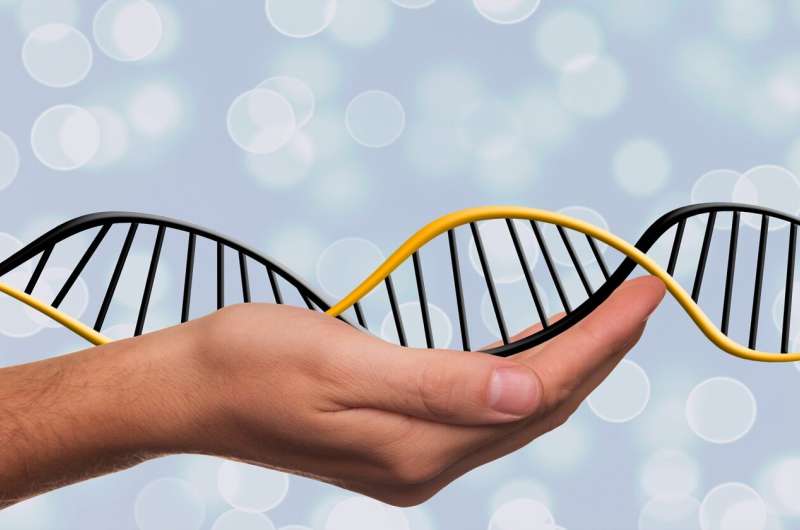Speeding up evolution at the genome level by alternative chromosome configuration

A research team led by André Marques at the Max Planck Institute for Plant Breeding Research in Cologne, Germany, has uncovered the profound effects of an atypical mode of chromosome arrangement on genome organization and evolution. Their findings are published in the journal Cell.
In each individual cell in our body, our DNA, the molecule carrying the instructions for development and growth, is packaged together with proteins into structures called chromosomes. Full sets of chromosomes together constitute the genome, the entire genetic information of an organism. In most organisms, including us, chromosomes appear as X-shaped structures when they are captured in their condensed, duplicated states in preparation for cell division. Indeed, these structures may be among the most iconic in all of science. The X shape is due to a constricted region called the centromere that serves to connect sister chromatids, which are the identical copies formed by the DNA replication of a chromosome. Most studied organisms are ‘monocentric’, meaning that centromeres are restricted to a single region on each chromosome. Several animal and plant organisms, however, show a very different centromere organization: instead of one solitary constriction as in the classic X-shaped chromosomes, chromosomes in these organisms harbor multiple centromeres that are arranged in a line from one end of a sister chromatid to the other. Thus, these chromosomes lack a primary constriction and the X shape, and species with such chromosomes are known as ‘holocentric’, from the ancient Greek word hólos meaning ‘whole’.
A new study led by André Marques from the Max Planck Institute for Plant Breeding Research in Cologne, Germany, now reveal the striking effects of this non-classical mode of chromosome organization on genome architecture and evolution.
To determine how holocentricity affects the genome, Marques and his team used highly accurate DNA sequencing technology to decode the genomes of three closely related holocentric beak-sedges, grass-like flowering plants found worldwide that are often the first conquerors of new habitats. For reference, the team also decoded the genome of their most closely related monocentric relative. Thus, comparing the holocentric beak-sedges with their monocentric relative allowed the authors to attribute any differences they observed to the effects of holocentricity.
Their analyses reveal striking differences in genome organization and chromosome behavior in holocentric organisms. They found that centromere function is distributed across hundreds of small centromere domains in holocentric chromosomes. While in monocentric organisms, genes are largely concentrated distant from centromeres and the regions immediately around them, in holocentric species they are uniformly distributed over the whole length of chromosomes. Further, in monocentric species chromosomes are known to engage in a high degree of intermingling with each other during cell division, a property which appears to play a role in regulating gene expression. Notably, these long-range interactions were sharply diminished in the beak-sedges with holocentromeres. Thus, holocentricity fundamentally affects genome organization as well as how chromosomes behave during cell division.
In holocentric organisms, almost any given chromosomal fragment will harbor a centromere and will thus have proper centromere function, which is not true for monocentric species. In this way, holocentromeres have been thought to stabilize chromosomal fragments and fusions and thus promote rapid genome evolution, or the ability of an organism to make prompt, wholesale changes to its DNA. In one of the beak-sedges they analyzed, Marques and his team could show that chromosome fusions facilitated by holocentromeres allowed this species to maintain the same chromosome number even after quadruplication of the entire genome. In another of their analyzed beak-sedges, a species with only two chromosomes, the lowest of any plant, holocentricity was found to be responsible for the dramatic reduction in chromosome number. Thus, holocentric chromosomes may allow the formation of news species through rapid evolution at genome-level.
According to Marques, “Our study shows that the transition to holocentricity has greatly influenced the way genomes are organized and regulated as well as allowing genomes to evolve rapidly through fusing their chromosomes together.” The team’s findings also show exciting implications for plant breeding, which typically relies on the ability to swap DNA and genes between chromosomes and organisms. “Holocentric plants allow the swapping of DNA in the vicinity of centromeres, something which is normally suppressed in monocentric species. Understanding how holocentrics do this could allow us to ‘unlock’ those genes in monocentric species and make them accessible for the breeding of better- performing, more resistant crop species.”
Protein complex SMC shown to ensures the dynamics of holocentromeres
Paulo G. Hofstatter et al, Repeat-based holocentromeres influence genome architecture and karyotype evolution, Cell (2022). DOI: 10.1016/j.cell.2022.06.045
Citation:
Speeding up evolution at the genome level by alternative chromosome configuration (2022, August 4)
retrieved 5 August 2022
from https://phys.org/news/2022-08-evolution-genome-alternative-chromosome-configuration.html
This document is subject to copyright. Apart from any fair dealing for the purpose of private study or research, no
part may be reproduced without the written permission. The content is provided for information purposes only.
For all the latest Science News Click Here
For the latest news and updates, follow us on Google News.

